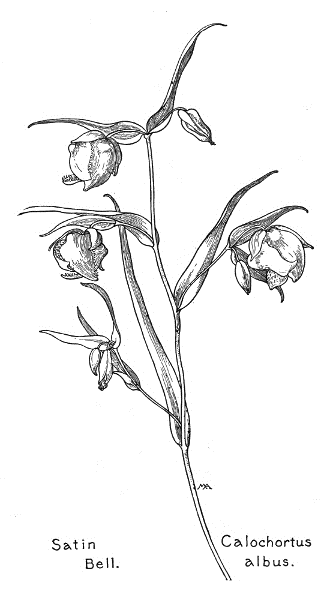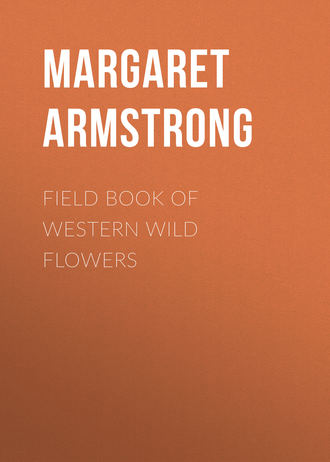 полная версия
полная версияField Book of Western Wild Flowers
Bronze Bells
Brown Fritillary
Fritillària atropurpùrea
Brown
Spring, summer
West
This plant is beautiful and decorative, and yet there is something weird about it. The flowers, an inch or more across, grow four or five in a cluster, on a smooth stalk about a foot tall, the long, narrow leaves scattered or in whorls. The bells, nodding on slender flower-stalks, are very unusual in coloring. They are greenish-yellow, streaked and spotted with maroon, and the long curling tips of the three-pronged pistil project like the forked tongue of an adder, so that somehow we feel that, in a previous existence, beautiful as it is now, it may have been a toad or some reptile. When we found this flower growing in the Grand Canyon, halfway down Bright Angel trail, it seemed entirely suitable to the mysterious spirit of the place. The general effect is bronze-color and the attractive name of Bronze Bells, or Mission Bells, is very appropriate. It has a small bulb of numerous, roundish scales. The pistils are often rudimentary.
Yellow Fritillary
Fritillària pùdica
Yellow
Spring
West, except Ariz.
A pretty little flower, a favorite with children, growing on grassy plains, with a smooth stem about six inches tall, and smooth, somewhat thickish, alternate or whorled leaves. The nodding flowers, about an inch long, are usually single, but sometimes as many as six on a stalk, various shades of yellow and orange, tinged with crimson and fading to dull-red. The smooth bulb is pure white, and made up of a number of rounded, thickish scales not resembling grains of rice, so the name Rice Root is not appropriate and the local Utah names, Crocus, Snowdrop, and Buttercup are absurd.
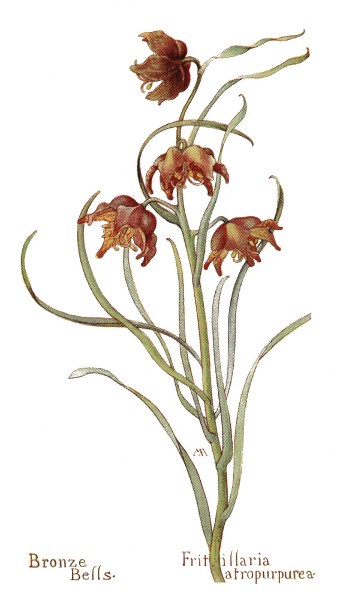
Bronze Bells – Fritillaria atropurpurea.

Yellow Fritillary – Fritillaria pudica.
There are several kinds of Yucca, natives of North and Central America; large plants, with dagger-like leaves, usually with long, thread-like fibers along the margins; flowers with bracts, nodding in a terminal cluster, somewhat bell-shaped, with six, thickish, white divisions; stamens short, with thickened filaments and small anthers; ovary with three united stigmas; capsule containing many, flat, black seeds. The flowers are pollinated by a little white moth, which lays its eggs in the ovary, but previously gathers pollen from many flowers and pushes it against the stigma after the eggs have been laid.
Our Lord's Candle
Spanish Bayonet
Yúcca Whípplei
White
Spring, summer
Cal., Ariz.
A noble plant, with no trunk, but sending up a magnificent shaft of flowers, from five to fifteen feet tall, springing from a huge, symmetrical bunch of dagger-like, bluish-green leaves. The cluster is composed of hundreds of waxy, cream-colored blossoms, sometimes tinged with purple, two inches across, crowded so closely together along the upper part of the stalk that the effect is a great, solid mass of bloom, three feet long. The white filaments are swollen, tipped with pale-yellow anthers; the pistil cream-color, with green stigmas. The large, white bracts are stiff and coarse, something like parchment, folded back so that the pinkish stalk is ornamented with a series of white triangles, symmetrically arranged. A hillside covered with hundreds of these magnificent spires of bloom, towering above the chaparral, is a wonderful sight. After they have blossomed, the tall, white stalks remain standing for some time, so that the hills look as if they had been planted with numbers of white wands.
The genus Cleistoyucca resembles Yucca, but the divisions of the flower are very thick and there is no style.
Joshua Tree
Tree Yucca
Cleistoyúcca arboréscens(Yucca)
Greenish-white
Spring, summer
Cal., Ariz., Utah
A tree, grotesque and forbidding in aspect, but with a weird sort of beauty, looming black against the pale desert landscape, with a great, thick, rough trunk, fifteen to thirty feet high, and a few thick, contorted branches, stretching out like a giant's arms and pointing ominously across the sandy waste. The branches are thatched with the shaggy husks of dead leaves and from their tips they thrust out a great bunch of dagger-like leaves and a big, ponderous cluster of pallid, greenish flowers or heavy, yellowish fruits. The coarse flowers are about two inches across, with a clammy smell like toadstools, and the bracts are dead white. This grows in the Mohave Desert and is at its best around Hesperia, where one may see the most fantastic forest that it is possible to imagine. Elsewhere it is smaller and more like other Yuccas in shape. It was called Joshua Tree by the early settlers, it is said because they fancied that its branches pointed towards the Promised Land. The fruits are relished by the Indians, who utilize the fibers from the leaves for weaving baskets, ropes, hats, horse-blankets, etc., and make a pulp from the stems, used for soap.
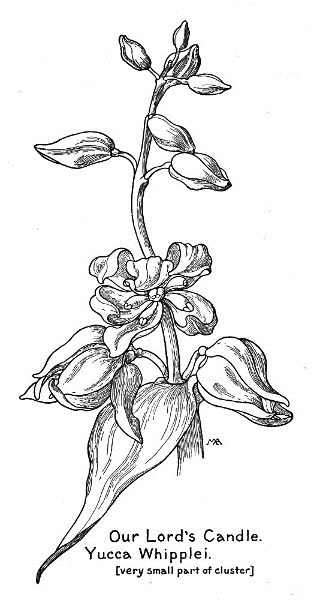
Our Lord's Candle – Yucca Whipplei.
[very small part of cluster]

There are several kinds of Trillium, of North America and Asia; with tuberous root-stocks; three, netted-veined leaves, in a whorl at the top of the stem; a single flower with three, green sepals, three petals, six, short stamens, and three styles; capsule berry-like and reddish, containing many seeds. The Latin name means "triple."
Wake-robin
Birthroot
Tríllium ovàtum
White
Spring, summer
Northwest
A charming plant, about a foot tall, with a single beautiful blossom, set off to perfection by its large, rich green leaves. The flower is two or three inches across, with lovely white petals, which gradually change to deep pink. It is a pleasure to find a company of these attractive plants in the heart of the forest, where their pure blossoms gleam in the cool shade along some mountain brook. They resemble the eastern Large-flowered Trillium and grow in the Coast Ranges.

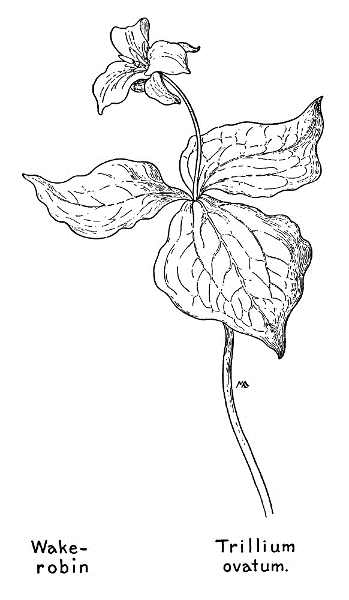
Wake-robin – Trillium ovatum.
There are three kinds of Xerophyllum.
Squaw-grass
Bear Grass
Xerophýllum tènax
WhiteSummer
Northwest
This is a magnificent plant, from two to six feet high, with a very stout, leafy stem, springing from a very large tuft of wiry, grass-like leaves, which spread out gracefully like a fountain. They are from one to two and a half feet long, dark-green on the upper side and pale-gray on the under, with rough edges. The imposing flower cluster is borne at the top of the stalk and is about a foot long, broad at the base and tapering to a blunt point, and composed of hundreds of fragrant, cream-white flowers, each about half an inch across, with slender, white pedicels, and so closely crowded together that the effect is very solid, yet made feathery by the long stamens. It is a fine sight to come across a company of these noble plants in a mountain meadow, rearing their great shafts of bloom far above their neighbors. They are very handsome around Mt. Rainier. They are said to blossom only once in five or seven years and then to die. The leaves are used by Indians in making their finest baskets. Unfortunately the size of this book does not admit of an illustration.
There are two kinds of Maianthemum, an eastern one and the following, which also grows in Europe and Asia.
Wild Lily-of-the-valley
Maiánthemum bifòlium
White
Spring, summer
Wash., Oreg., Cal.
This is a very attractive, woodland plant, from four to fourteen inches tall, with handsome, glossy, rich green leaves, and a rather stout stem, bearing a pretty cluster, two or three inches long, of many, small, waxy-white flowers, with four divisions. They have four stamens, with thread-like filaments and small, yellowish anthers, the stigma has two lobes and the berry is red. This grows in rich soil in the mountains and is much handsomer than its eastern relation and strongly sweet-scented. The Latin name means "blooming in May."
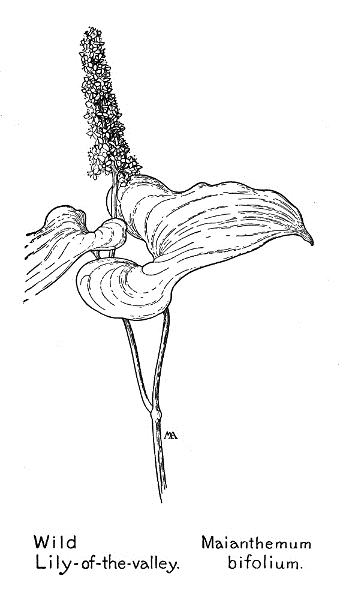
Wild Lily-of-the-valley – Maianthemum bifolium.
There are several kinds of Streptopus, much like Disporum, but the pedicels of the flowers are twisted or bent.
White Twisted Stalk
Stréptopus amplexifòlius
Whitish
Spring, summer
U. S. except Southwest
This is a fine plant, two or three feet tall, with a smooth, branching, bending stem and handsome leaves, thin in texture, with strongly marked veins and pale with whitish "bloom" on the under side. The greenish-white flowers are about half an inch long and hang on very slender, crooked pedicels, from under the leaves, and the oval berries are red and contain many seeds. This grows in moist soil, in cold mountain woods, up to an altitude of ten thousand feet and across the continent. The Greek name means "twisted stalk."
Pink Twisted Stalk
Stréptopus ròseus
PinkSpring, summer
U. S. except Southwest
A smaller plant, from one to two and a half feet tall, with a slightly hairy stem, ornamented with pretty leaves, green on both sides and hairy along the edges, and hung with pretty, little, dull purplish-pink flowers, more or less streaked with deeper color and less than half an inch long. This grows in the same sort of places as the last and is also found across the continent.
There are two kinds of Stenanthella; smooth herbs, with bulbs and small nodding flowers, in bracted clusters, the divisions of the perianth separate, without glands or distinct claws; the short stamens inserted at the base of the divisions; the styles three; the capsule with three beaks and containing oblong, winged seeds.
Stenanthella
Stenanthélla occidentàlis
Brownish
Spring, summer
Northwest
This is a graceful plant, from ten to twenty inches tall, with long, rather narrow leaves and a slender stem, terminating in a long spray of about ten, rather pretty, little brownish-green or purplish flowers, each less than half an inch long. This grows in shady places.
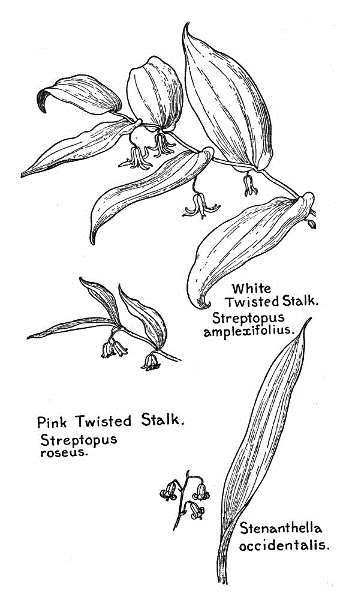
White Twisted Stalk – Streptopus amplexifolius.
Pink Twisted Stalk – Streptopus roseus.
Stenanthella occidentalis.
There are several kinds of Camassia, one eastern; herbs with onion-like bulbs, long, narrow leaves and thin, dry bracts. The flowers are blue of various shades, with six, separate, somewhat spreading divisions, each with a stamen on its base, the anthers swinging, the style threadlike, with a three-cleft tip; the capsule three-lobed, with several seeds in each compartment. Varieties of Camassia have long been cultivated in European gardens. The name is derived from Quamash, the Indian name for these plants.
Camass, Quamash
Camássia quámash
Blue
Summer
Northwest and Utah
Looking across the vivid green of wet meadows and marshes, the deep blue patches of this flower are often conspicuous and beautiful. They grow from one to over two feet high, taller than the grasslike leaves, forming a loose cluster, with papery bracts. The flowers are from an inch and a half to over two inches across, the six divisions spreading out into a star. The buds are tinged with turquoise-blue and striped with purple, giving a fine iridescent effect, and the flowers, which fade very quickly, are often exceedingly handsome, varying in color from dark-blue to white, but usually deep, bright purplish-blue, with a green ovary, a long purple style and yellow anthers, with purple filaments. They are larger and handsomer in northern California than in Yosemite. Grizzly bears are fond of the bulbs and the Indians of the Northwest prized them as a delicacy, indeed the Nez Percé war in Idaho was caused by encroachments on a territory where they were abundant. They were cooked elaborately in pits, care being taken to avoid the poisonous bulbs of the Death Camass, which resemble them. The Indians also boil the bulbs in water and make good molasses from them, which they use on festive occasions. This is sometimes called Wild Hyacinth, but the name is poor, as it does not resemble a hyacinth in character.
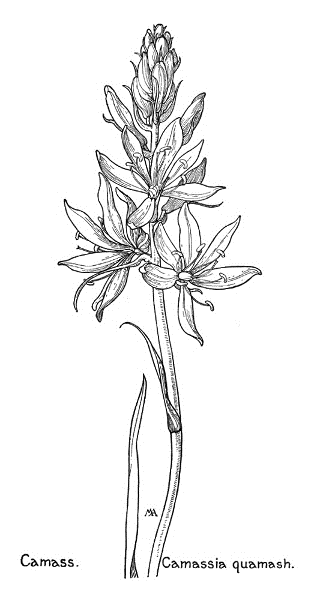
Camass – Camassia quamash.
There are six kinds of Clintonia, of North America and Asia; with creeping rootstocks and a few, broad root-leaves; flowers without bracts, their divisions separate, equal or nearly so, each with a stamen at its base; style with two or three, inconspicuous lobes; fruit a berry. These plants were named in honor of De Witt Clinton, Governor of New York, a naturalist, interested in botany, so Thoreau need not have been so annoyed at their having been given this name.
Red Clintonia
Clintònia Andrewsiàna
Red, pink
Spring, summer
Oreg., Cal.
A magnificent plant, one or two feet high, with five or six, exceedingly handsome, glossy, rich green leaves, very conspicuous and sometimes a foot long, and a tall, slightly downy flower-stalk, usually with a few flowers scattered along it, and crowned with a large, roundish cluster of beautiful flowers. They are about three-quarters of an inch long, very rich in color, a deep shade of warm reddish-pink, or crimson, not common in flowers. The form of the cluster varies a good deal; sometimes the flowers are not mostly at the top, but clustered quite thickly along all the upper part of the stalk. The large, deep-blue berries are very handsome and, altogether, this is one of our most conspicuous and attractive woodland plants, especially when growing in the deep shade of redwood forests.
Queen-cup White Clintonia
Clintònia uniflòra
White
Spring
Northwest
In rich moist soil, in shady woods, we find this lovely flower, with a white chalice and heart of pale gold, surrounded by two or three, beautiful, large, glossy leaves, resembling those of Lily-of-the-valley, and fairly carpeting the ground in favorable situations. The slender flower-stalk is hairy, six to ten inches tall, and usually bears a single flower, an inch or more across, with pure-white petals that soon drop off. The fruit is a handsome blue berry.
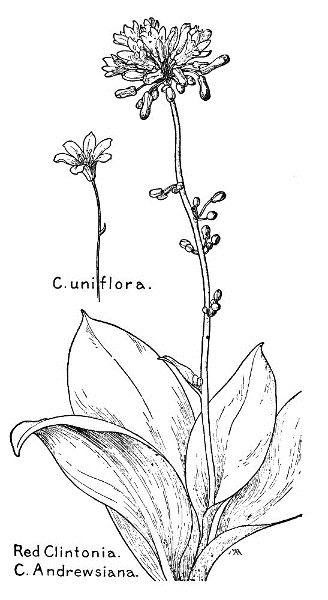
C. uniflora.
Red Clintonia – C. Andrewsiana.
There are a good many kinds of Vagnera, natives of America and Asia, with a single stem, scaly below and leafy above; the leaves alternate, with short leaf-stalks or none; the flowers small, the divisions equal and spreading, white or greenish, in a cluster; the berry round, usually with one or two seeds.
False Solomon's Seal.
Wild Spikenard
Vágnera amplexicàulis(Smilacina)
White
Spring
West
It is a pity that all flowers cannot have really individual names. "False" is especially unattractive and "Solomon's Seal" is confusing, as the flowers are not alike, but this is the old name used all over the world, so it will have to stand, though unworthy of this pleasing plant. It is from one to three feet high, with large, light-green leaves, usually slightly downy on the under side. The flower-cluster is sweet-scented and composed of numerous, very small, cream-white flowers, the conspicuous parts of which are the stamens, white and larger than the petals, giving a feathery appearance to the whole cluster. The fruit is a light-red berry, very finely sprinkled with dark-red dots. This fine tall plant is very decorative and is common in rich moist woods. The name was given in honor of Wagner.
Star-flowered Solomon's Seal
Vágnera sessilifòlia(Smilacina)
White
Spring
West
A gracefully bending plant, from one to two feet high, springing from a slender root-stock. The bright light-green leaves, without leaf-stalks and clasping at base, have a slight "bloom" like some lily leaves and are handsome and conspicuous, but not at all coarse, and are usually very smooth, but sometimes minutely downy. The small, delicate, cream-white flowers, on a very slender, angled flower-stalk, grow in a loose cluster and the berries are reddish-purple or nearly black. This charming plant sometimes forms large patches in moist, rich soil in shady places and its pretty foliage is often very noticeable beside the railroad tracks in Utah.
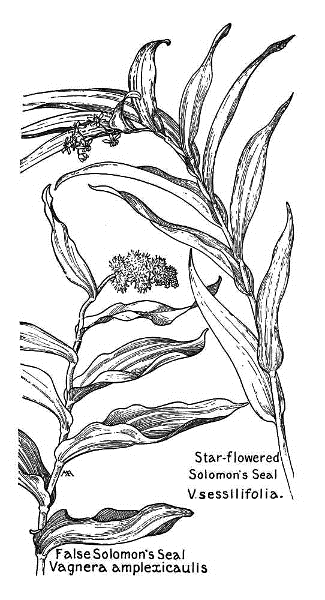
Star-flowered Solomon's Seal – V. sessilifolia.
False Solomon's Seal – Vagnera amplexicaulis.

Fairy Bells are graceful plants, growing in rich, moist, mountain woods, with smoothish, or slightly hairy, branching stems, leafy above and with scaly bracts below, springing from slender root-stocks; leaves netted-veined, alternate, without leaf-stalks, smooth and thin in texture and often clasping the stem; rather small, bell-shaped flowers, hanging from under the leaves, with six stamens and a slender style, with one or three stigmas; the fruit a yellow or red berry. Disporum is from the Greek meaning "double-seed," as in some kinds there are two seeds in each cell of the ovary.
Fairy Bells
Drops of Gold
Dísporum trachycàrpum(Prosartes)
Yellowish-white
Spring, summer
West
A very attractive mountain plant, growing near streams. It is from nine to twenty-four inches tall, with an angled stem, pale green above and reddish below. The delicate flowers, about half an inch long, with a three-lobed green stigma and yellow anthers, grow singly or in clusters of two or three, nodding shyly under the pretty leaves, which are dull above and very shiny on the under side, with oddly crumpled edges and set obliquely on the stem. The berry when unripe is orange color and suggested the name Drops of Gold, but becomes bright red when it matures in June. D. Hookeri is similar, but the style is not three-lobed and the leaves are slightly rough to the touch and are not so thin or crumpled. They spread out so flat that they make a green roof over the flowers, completely screening them from the passer-by. This grows in shady woods, but not near streams.
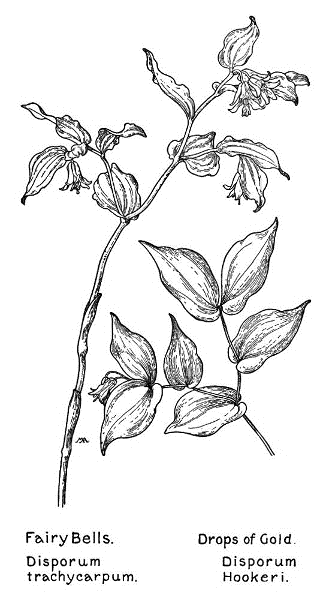
Fairy Bells – Disporum trachycarpum.
Drops of Gold – Disporum Hookeri.
Perhaps the most characteristic western flowers are the members of the genus Calochortus. They grow freely all through the West, as far north as British America, and down into Mexico, but they never get east of Nebraska, so these gay and graceful flowers may be considered the peculiar property of the West. Calochortus means "beautiful grass" and the leaves are usually grasslike, the stems slender and the flowers bright in color, decorative and interesting in form. They have three sepals, often greenish, and three large, colored petals, with a honey-gland, usually covered with hairs, at the base of each. They are allied to true Tulips, so the popular name is suitable, and they fall into three groups: Globe Tulips, with nodding, globular flowers, and nodding capsules; Star Tulips, with erect, star-like flowers and nodding capsules; and Mariposa Tulips, with large, somewhat cup-shaped flowers and erect capsules. Mariposa means "butterfly" in Spanish and is appropriate, for the brilliant hairy spots on the petals are wonderfully like the markings of a butterfly's wing and the airy blossoms seem to have but just alighted on the tips of their slender stalks. They usually grow on dry open hillsides and their leaves have often withered away before the flowers bloom. The various forms run into each other, so that it is impossible to determine all the different species. They have solid bulbs, some of which are edible, considered a delicacy by the Indians and called Noonas.
Golden Lily Bell
Yellow Globe Tulip
Calochórtus amàbilis
Yellow
Spring
California
A charming plant, with pale bluish-green foliage, with a beautiful "bloom," which sets off the clear-yellow blossoms to perfection. There are from two to twenty flowers on each stem and the petals are smooth, except for a neat, stiff fringe of hairs along the margins and the matted hairs on the glands, which are often reddish. These lovely flowers, common in northern California, are peculiarly fresh in color and when growing among the grass in the shade of oak trees they have the springlike charm of Daffodils in English woods.
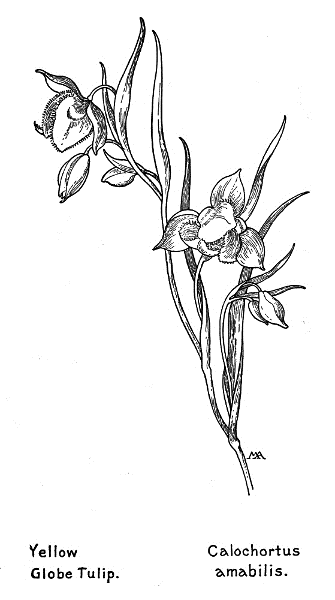
Yellow Globe Tulip – Calochortus amabilis.

Satin-bell.
White Globe Tulip
Calochórtus álbus
White
Spring
California
Beautiful and popular flowers, with a great deal of individuality and quite Japanese in the decorative arrangement of the graceful stems and glossy, rich green foliage. The narrow root-leaf is over a foot long and spreads on the ground and other smaller leaves are disposed along the bending stem, which is from one to two feet tall and hung with pretty light-green buds and beautiful drooping blossoms, over an inch long, pearly white, sometimes tinged with lilac, with a satiny sheen and delicate yet crisp in texture. The papery sepals are greenish-white and the petals are sometimes tinged with purple at the base and are prettily fringed with hairs along the edges and often cross their tips in a very engaging way. They are covered inside with long, silky, white or yellow hairs and the glands are crescent-shaped, with close, short, sticky, white or yellow hairs, and form pale-green humps on the outside of the petals; the anthers are cream-color and the pistil whitish. The capsule is one or two inches long, with a short beak and brown seeds. These plants grow on shady banks in the Coast Ranges and have several pretty common names, such as Lantern of the Fairies and Alabaster Tulip, as well as the misleading name Hairbell, which causes this flower to be confused with the Harebell or Campanula.

